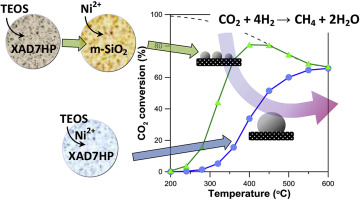Microporous and Mesoporous Materials ( IF 5.2 ) Pub Date : 2018-06-13 , DOI: 10.1016/j.micromeso.2018.06.022 Wojciech Gac , Witold Zawadzki , Grzegorz Słowik , Andrzej Sienkiewicz , Agnieszka Kierys

|
Nickel catalysts supported on silica microspheres were prepared by the application of porous resin beads (Amberlite XAD7HP) as hard template using different order of nickel nitrate and tetraethoxysilane (TEOS) introduction. Large nickel oxide nanoparticles distributed over silica microspheres were formed when nickel precursor was introduced directly to the polymer template prior to the silica framework development or added into the silica-polymer composites. On the other hand, an impregnation of as-prepared silica microspheres after template removal led to the formation of small nickel oxide nanoparticles. The catalysts showed hierarchical pore structure. Low-temperature nitrogen adsorption/desorption and photoacoustic Fourier-transform infrared spectroscopy studies revealed slight changes of porosity and surface properties of catalysts affected by the synthesis methods. X-ray diffraction, scanning and transmission electron microscopy, temperature-programmed reduction and hydrogen desorption studies were used for determination of the properties of metallic nickel nanoparticles. It was stated that the activity and selectivity of catalysts in the CO2 methanation reaction was related to the active surface area and the size of nickel nanoparticles. An increase in CO2 conversion and selectivity to methane at low temperatures (220–350 °C) with an increase in active surface area and decrease in nickel crystallite size was observed.
中文翻译:

负载在二氧化硅微球上的镍催化剂用于CO 2甲烷化
通过使用多孔树脂珠(Amberlite XAD7HP)作为硬模板,使用不同顺序的硝酸镍和四乙氧基硅烷(TEOS)引入,制备了负载在二氧化硅微球上的镍催化剂。当在二氧化硅骨架开发之前将镍前体直接引入到聚合物模板中或将其添加到二氧化硅-聚合物复合物中时,形成了分布在二氧化硅微球上的大的氧化镍纳米粒子。另一方面,在去除模板后浸渍制得的二氧化硅微球会导致形成小的氧化镍纳米粒子。催化剂显示出分层的孔结构。低温氮吸附/解吸和光声傅里叶变换红外光谱研究表明,受合成方法影响的催化剂的孔隙率和表面性能略有变化。X射线衍射,扫描和透射电子显微镜,程序升温还原和氢解吸研究用于确定金属镍纳米粒子的性能。据指出,催化剂在CO中的活性和选择性2甲烷化反应与活性表面积和镍纳米粒子的尺寸有关。在低温(220–350°C)下,随着活性表面积的增加和镍微晶尺寸的减小,CO 2转化率和对甲烷的选择性增加。



























 京公网安备 11010802027423号
京公网安备 11010802027423号